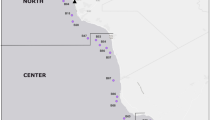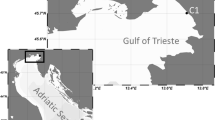Abstract
Marine sponges have been suggested to play an important role in the marine nitrogen cycling. However, the role of sponge microbes in the nitrogen transformation remains limited, especially on the bacterial ammonia oxidization and denitrification. Hence, in the present study, using functional genes (amoA, nirS, nirK, and nxrA) involved in ammonia oxidization and denitrification and 16S rRNA genes for specific bacterial groups as markers, phylogenetically diverse prokaryotes including bacteria and archaea, which may be involved in the ammonia oxidization and denitrification processes in sponges, were revealed in seven sponge species. Ammonia oxidizers were found in all species, whereas three sponges (Placospongia sp., Acanthella sp., and Pericharax heteroraphis) harbor only ammonia-oxidizing bacteria (AOB), two sponges (Spirastrellidae diplastrella and Mycale fibrexilis) host only ammonia-oxidizing archaea (AOA), while the remaining two sponges (Haliclona sp. and Lamellomorpha sp.) harbor both AOB and AOA. S. diplastrella and Lamellomorpha sp. also harbor denitrifying bacteria. Nitrite reductase gene nirK was detected only in Lamellomorpha sp. with higher phylogenetic diversity than nirS gene observed only in S. diplastrella. The detected functional genes related to the ammonia oxidization and nitrite reduction in deep-sea and shallow-water sponges highlighted the potential ecological roles of prokaryotes in sponge-related nitrogen transformation.




Similar content being viewed by others
References
Bayer K, Schmitt S, Hentschel U (2008) Physiology, phylogeny and in situ evidence for bacterial and archaeal nitrifiers in the marine sponge Aplysina aerophoba. Environ Microbiol 10:2942–2955
Braker G, Zhou J, Wu L, Devol AH, Tiedje JM (2000) Nitrite reductases genes (nirK and nirS) as functional markers to investigate diversity of denitrification bacteria in Pacific Northwest marine sediment communities. Appl Environ Microb 66:2096–2104
Christopher A, Francis KJR, Michael J, Brian BO (2005) Ubiquity and diversity of ammonia-oxidizing archaea in water columns and sediments of the ocean. Proc Natl Acad Sci U S A 102:14683–14688
Codispoti LA, Brandes JA, Christensen JP, Devol AH, Naqvi SWA, Paerl HW et al (2001) The oceanic fixed nitrogen and nitrous oxide budgets: moving targets as we enter the anthropocene? Sci Mar 65:85–105
Di HJ, Cameron KC, Shen JP, Winefield CS, O'Callaghan M, Bowatte S et al (2009) Nitrification driven by bacteria and not archaea in nitrogen-rich grassland soils. Nat Geosci 2:621–624
Diaz MC, Ward BB (1997) Sponge-mediated nitrification in tropical benthic communities. Mar Ecol Prog Ser 156:97–107
Diaz MC, Akob D, Cary CS (2004) Denaturing gradient gel electrophoresis of nitrifying microbes associated with tropical sponges. In: Pansini M, Pronzato R, Baverstrello G, Manconi R (eds) Sponge science in the new millennium. Boll Mus 1st Biol Univ Genova 68:279–289
Degrange V, Bardin R (1995) Detection and counting of Nitrobacter populations in soil by PCR. Appl Environ Microb 61:2093–2098
Fiore CL, Jarett JK, Olson ND, Lesser MP (2010) Nitrogen fixation and nitrogen transformations in marine symbioses. Trends Microbiol 18:455–463
Gao Z, Li B, Zheng C, Wang G (2008) Molecular detection of fungal communities in the Hawaiian marine sponges Subertes zeteki and Mycale armata. Appl Environ Microb 74:6091–6101
Han M, He L, Lin H, Li Z (2012) Bacterial and archaeal symbionts in the South China Sea sponge Phakellia fusca: community structure, relative abundance, and ammonia-oxidizing populations. Mar Biotechnol 14:701–713
Hentschel U, Hopke J, Horn M, Friedrich AB, Wagner M, Kacker J et al (2002) Molecular evidence for a uniform microbial community in sponges from different oceans. Appl Environ Microb 68:4431–4440
Heylen K, Gevers D, Vanparys B, Wittebolle L, Geets J, Boon N et al (2006) The incidence of nirS and nirK and their genetic heterogeneity in cultivated denitrifiers. Environ Microbiol 8:2012–2021
Hoffmann F, Radax R, Woebken D, Holtappels M, Lavik G, Rapp HT et al (2009) Complex nitrogen cycling in the sponge Geodia barretti. Environ Microbiol 11:2228–2243
Holmes BM, Blanch HW (2006) Genus-specific associations of marine sponges with group I creanarchaeotes. Mar Biol 150:759–772
Jiménez E (2007) Sponge as a source of dissolved inorganic nitrogen: nitrification mediated by temperate sponges. Limnol Oceanogr 52:948–958
Kober KM, Nichols SA (2007) On the phylogenetic relationships of hadromerid and poecilosclerid sponges. J Mar Biol Assoc UK 87:1585–1598
Lee OO, Wang Y, Yang JK, Lafi F, Al-Suwailem A (2011) Pyrosequencing reveals highly diverse and species-specific microbial communities in sponges from the Red Sea. ISME J 5:650–664
López-Legentil S, Erwin PM, Pawlik JR, Song B (2010) Effects of sponge bleaching on ammonia-oxidizing archaea: distribution and relative expression of ammonia monooxygenase genes associated with the Barrel sponge Xestospngia muta. Microb Ecol 60:561–571
Meyer B, Kuever J (2008) Phylogenetic diversity and spatial distribution of the microbial community associated with the Caribbean deep-water sponge Polymastia cf. corticata by 16S rRNA, aprA, and amoA gene analysis. Microb Ecol 56:306–321
Mohamed NM, Saito K, Tal Y, Hill RT (2010) Diversity of aerobic and anaerobic ammonia-oxidizing bacteria in marine sponges. ISME J 4:38–48
Mohamed NM, Colman AS, Tal Y, Hill RT (2008) Diversity and expression of nitrogen fixation genes in bacterial symbionts of marine sponges. Environ Microbiol 10:2910–2921
Poly F, Wertz S, Brothier E, Degrange V (2008) First exploration of Nitrobacter diversity in soils using functional gene nxrA encoding nitrite oxido-reductase. FEMS Microbiol Ecol 63:132–140
Rotthauwe JH, Witzel KP, Liesack W (1997) The ammonia monooxygenase structural gene amoA as a functional marker: molecular fine-scale analysis of natural ammonia-oxidizing populations. Appl Environ Microb 63:4704–4712
Schläppy M, Schöttner SI, Lavik G, Kuypers MMM, de Beer D, Hoffmann F (2010) Evidence of nitrification and denitrification in high and low microbial abundance sponges. Mar Biol 157:593–602
Schläppy M, Weber M, Mendola D, Hoffmann F, de Beer D (2010) Heterogeneous oxygenation resulting from active and passive flow in two Mediterranean sponges, Dysidea avara and Chondrosia reniformis. Limnol Oceanogr 55:1289–1300
Schloss PD, Handelsman J (2005) Introducing DOTUR, a computer program for defining operational taxonomic units and estimating species richness. Appl Environ Microb 71:1501–1506
Schmid MC, Maas B, Dapena A, van de Pas-Schoonen K, van de Vossenberg J, Kartal B et al (2005) Biomarkers for in situ detection of anaerobic ammonium-oxidizing (anammox) bacteria. Appl Environ Microb 71:1677–1684
Schmitt S, Tsai P, Bell J, Fromont J, Ilan M, Lindquist N et al (2012) Assessing the complex sponge microbiota: core, variable and species-specific bacterial communities in marine sponges. ISME J 6:564–576
Siegl A, Kamke J, Hochmuth T, Piel J, Richter M, Liang C et al (2011) Single-cell genomics reveals the lifestyle of Poribacteria, a candidate phylum symbiotically associated with marine sponges. ISME J 5:61–70
Smedile F, Messina E, La Cono V, Tsoy O, Monticelli L et al (2012) Metagenomic analysis of hadopelagic microbial assemblages thriving at the deepest part of Mediterranean Sea, Matapan-Vavilov Deep. Environ Microbiol. doi:10.1111/j.1462-2920.2012.02827.x
Southwell MW, Popp BN, Martens CS (2008) Nitrification controls on fluxes and isotopic composition of nitrate from Florida Keys sponges. Mar Chem 108:96–108
Steger D, Ettinger-Epstein P, Whalan S, Hentschel U, de Nys R et al (2008) Diversity and mode of transmission of ammonia-oxidizing archaea in marine sponges. Environ Microbiol 10:1087–1094
Tamura K, Dudley J, Nei M, Kumar S (2007) MEGA4: molecular evolutionary genetics analysis (MEGA) software version 4.0. Mol Biol Evol 24:1596–1599
Taylor MW, Radax R, Steger D, Wagner M (2007) Sponge-associated microorganisms: evolution, ecology, and biotechnological potential. Microbiol Mol Biol R 71:295–347
Webster N, Taylor MW (2012) Marine sponges and their microbial symbionts: love and other relationships. Environ Microbiol 14:335–346
Webster NS, Taylor MW, Behnam F, Lücker S, Rattei T et al (2010) Deep sequencing reveals exceptional diversity and modes of transmission for bacterial sponge symbionts. Environ Microbiol 12:2070–2082
Wilkinson CR, Summons R, Evans E (1999) Nitrogen fixation in symbiotic marine sponges: ecological significance and difficulties in detection. Mem Queensl Mus 44:667–673
Wilkinson CR, Fay P (1979) Nitrogen fixation in coral reef sponges with symbiotic cyanobacteria. Nature 279:527–529
Wuchter C, Abbas B, Coolen MJ, Herndl GJ, Middelburg JJ et al (2006) Archaea nitrification in the ocean. Proc Natl Acad Sci U S A 103:12317–12322
Yang Z, Li Z (2012) Spatial distribution of prokaryotic symbionts and ammoxidation, denitrifier bacteria in marine sponge Astrosclera willeyana. Sci Rep 2:528
Zehr JP, Kudela RM (2011) Nitrogen cycle of the open ocean: from genes to ecosystems. Annu Rev Mar Sci 3:197–225
Zumft WG (1997) Cell biology and molecular basis denitrification. Microbiol Mol Biol R 61:533–616
Acknowledgments
Financial support from National Natural Science Foundation of China (41076077) is greatly acknowledged. The authors are grateful to Prof. Houwen Lin and Prof. Wen Zhang at Second Military Medical University (China) for assistance in collecting sponge samples and Liming He in identifying sponge samples.
Author information
Authors and Affiliations
Corresponding author
Electronic Supplementary Material
Below is the link to the electronic supplementary material.
ESM 1
(DOC 278 kb)
Rights and permissions
About this article
Cite this article
Han, M., Li, Z. & Zhang, F. The Ammonia Oxidizing and Denitrifying Prokaryotes Associated with Sponges from Different Sea Areas. Microb Ecol 66, 427–436 (2013). https://doi.org/10.1007/s00248-013-0197-0
Received:
Accepted:
Published:
Issue Date:
DOI: https://doi.org/10.1007/s00248-013-0197-0




